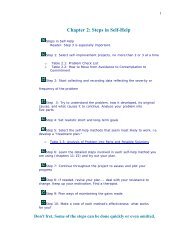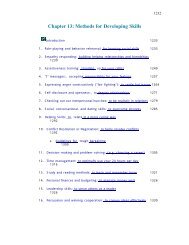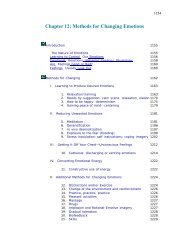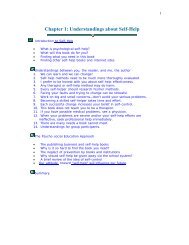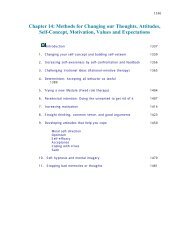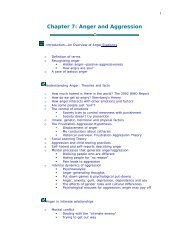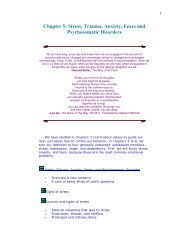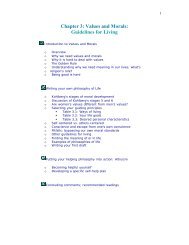Methods for Changing Behaviors - Psychological Self-Help
Methods for Changing Behaviors - Psychological Self-Help
Methods for Changing Behaviors - Psychological Self-Help
Create successful ePaper yourself
Turn your PDF publications into a flip-book with our unique Google optimized e-Paper software.
unemployed, etc. is an unpleasant chore. Why? Because we overlook<br />
the potential intrinsic satisfaction in these activities! (See a long<br />
section, Extrinsic and Intrinsic Motivation in chapter 4)<br />
A recent summary of 145 articles (Cameron, Banko, & Pierce,<br />
2001) in this area shows that providing extrinsic rewards following a<br />
behavior usually increases the intrinsic satisfaction one gets from<br />
per<strong>for</strong>ming that act. The exception to this is when the behavior is<br />
already quite interesting or satisfying and the reward entails some<br />
pressure or external control on the actor, <strong>for</strong> instance the delivery of<br />
the reward is contingent on successfully completing a specific step, or<br />
the reward is provided in such a way that it communicates to the actor<br />
that he/she is failing, doing poorly, or needs to speed up. A verbal<br />
reward, such as praise or positive comments, almost always increased<br />
the interest in the activity, even if it was already high in interest. Even<br />
tangible extrinsic rewards, like an award, increased interest if the<br />
rewards were given <strong>for</strong> simply finishing a task, <strong>for</strong> scoring above a<br />
certain level, <strong>for</strong> doing better than others, and <strong>for</strong> just solving a<br />
problem.<br />
Intrinsic motivation is high when the activity is interesting, is<br />
challenging but not too hard, requires some skill, arouses your<br />
curiosity, and permits the actor to make his/her own decisions,<br />
exercise control, set his/her own pace in pleasant surroundings, and<br />
can get totally into the behavior as it occurs. (See the discussion of<br />
flow near the end of the page.) Keep those points in mind as you<br />
carry out this method being sure you realize the high-interest activities<br />
may need to be rein<strong>for</strong>ced with rewards in different ways than lowinterest<br />
tasks.<br />
Deci (1975) recommends that employers pay a good salary in<br />
order to recruit a good employee and satisfy his/her basic needs. But<br />
the salary should not be used as an incentive <strong>for</strong> greater productivity<br />
because it interferes with intrinsic satisfaction from the work. How?<br />
Because we may start working <strong>for</strong> a salary increase or a commission-not<br />
<strong>for</strong> the pleasure of doing the work. Deci says the employee should<br />
be given (1) interesting, challenging tasks and responsibilities, (2)<br />
considerable control over how to solve the problems, and (3) support<br />
and good relationships with co-workers, which add up to intrinsic<br />
satisfaction. About the same recommendations are made <strong>for</strong> schools<br />
by critics of traditional schools.<br />
Purposes<br />
Steps<br />
· To enhance the intrinsic satisfaction in an activity.<br />
· To use the intrinsic satisfaction as our motivation instead of or<br />
in combination with extrinsic rewards.<br />
STEP ONE: Carefully identify the possible sources of intrinsic<br />
satisfaction in the activity.<br />
1120



